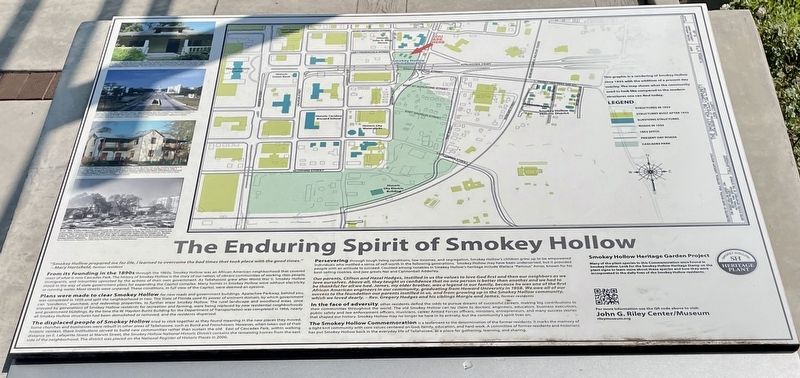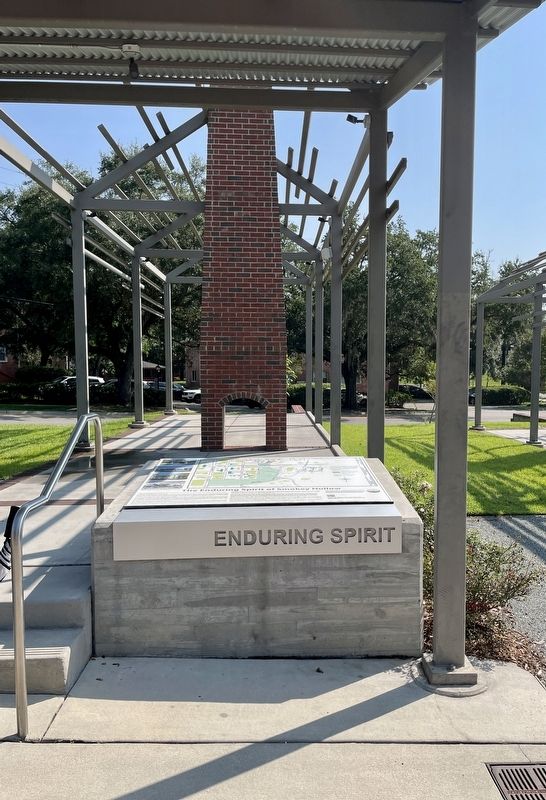Tallahassee in Leon County, Florida — The American South (South Atlantic)
The Enduring Spirit of Smokey Hollow
Cascades Park
"Smokey Hollow prepared me for life. I learned to overcome the bad times that took place with the good times.” - Mary Hartsfield, former resident
From it’s founding in the 1890s through the 1960s, Smokey Hollow was an African American neighborhood that covered most of what is now Cascades Park. The history of Smokey Hollow is the story of our nation, of vibrant communities of working class people, immigrants, and minorities uprooted by the actions of their own government. As Tallahassee grew after World War I, Smokey Hollow stood in the way of state government plans for expanding the Capitol complex. Many homes in Smokey Hollow were without electricity or running water. Most streets were unpaved. These conditions, in full view of the Capitol, were deemed an eyesore.
Plans were made to clear Smokey Hollow for new roads and government buildings. Apalachee Parkway, behind you, was completed in 1958 and split the neighborhood in two. The State of Florida used its power of eminent domain, by which government can "condemn," purchase, and redevelop properties, to further erase Smokey Hollow. The rural landscape and woodland areas, once enjoyed by generations of Smokey Hollow residents for recreation and farming, were being replaced by new residential neighborhoods and government buildings. By the time the W. Haydon Burns Building for the Department of Transportation was completed in 1966, nearly all Smokey Hollow structures had been demolished or removed, and the residents dispersed.
The displaced people of Smokey Hollow tried to stick together as they found meaning in the new places they moved. Some churches and businesses were rebuilt in other areas of Tallahassee, such as Bond and Frenchtown. However, when taken out of their historic context these institutions served to build new communities rather than sustain the old. East of Cascades Park, within walking distance on E. Lafayette Street at Marvin Street, the Smokey Hollow National Historic District contains the remaining homes from the east side of the neighborhood. The district was placed on the National Register of Historic Places in 2000.
Persevering through tough living conditions, low incomes, and segregation, Smokey Hollow's children grew up to be empowered individuals who instilled a sense of self-worth in the following generations. Smokey Hollow may have been underserved, but it provided people with an attitude to succeed. Counted among notables in Smokey Hollow's heritage include Wallace "Famous” Amos, known for his best-selling cookies, and Jazz greats Nat and Cannonball Adderley.
Our parents, Clifton and Hazel Hodges, instilled in us the values to love God first and then our neighbors as we love ourselves. Above all, they taught us confidence that no one person is better than another and we had to be thankful for all we had. James, my older brother, was a legend in our family, because he was one of the first African American engineers in our community, graduating from Howard University in 1958. We owe all of our success to the foundation our parents instilled in us, and from growing up in Smokey Hollow community, which we loved dearly. —Rev. Gregory Hodges and his siblings Margie and James, former residents
In the face of adversity, other residents defied the odds to pursue dreams of successful careers, making big contributions their communities throughout the world. The old Smokey Hollow can lay claim to doctors, engineers, educators, business executive, public safety and law enforcement officers, musicians, career Armed Forces officers, ministers, entrepreneurs, and many success stories that shaped our history. Smokey Hollow may no longer be here in its entirety, but the community's spirit lives on.
The Smokey Hollow Commemoration is a testament to the determination of the former residents. It marks the memory of a tight knit community with core values centered on God, family, education, and hard work. A committee of former residents and historians has put Smokey Hollow back in the everyday life of Tallahassee, as a place for gathering, learning, and sharing.
Smokey Hollow Heritage Garden Project
Many of the plant species in this Commemoration were found in Smokey Hollow. Look for the Smokey Hollow Heritage Stamp on the plant signs to learn more about these species and how they were incorporated in the daily lives of the Smokey Hollow residents.
(captions)
The Fisher Residence was home to Julius Fisher Sr. and his wife Annie, along with their children Susie, Robert and Julius Jr. The following generation to occupy the home Included Daisy Mae, Annie Lee, and Robert "Bob" Jr. The house is still located east of the railroad tracks on Marvin Street and is included in the Smokey Hollow National Register Historic District. The Fisher Residence, Tallahassee, Florida May 21, 2012, Courtesy of Blueprint 2000
This is a view of the State of Florida's Historic Capitol Building after the completion of Apalachee Parkway in 1958. The road cut through the northern half of the Smokey Hollow Community. View Down Apalachee Parkway looking at Florida's Old Capitol Building, Karl, E. Holland, Photographer, Tallahassee, Florida, November 1960, State Archives of Florida, Florida Memory
Professor John Gilmore Riley lived at 419 East Jefferson Street. His home was on the northern boundary of the community, across East Pensacola Street just northwest of where you are standing now. In 1996, it became the John G. Riley Center/Museum of African American History and Culture and is listed on the Local and National Register of Historic Places. Tallahassee, Florida, 2014, Photo Courtesy of the John G. Riley Center/Museum of African American History & Culture
In the 1960s, Smokey Hollow was considered by the state government to be a "small area of deteriorated and substandard residences separated from neighborhood and community facilities by construction of Apalachee Parkway." After several years of debate, plans were made to expand the Capitol Center Complex into Smokey Hollow. This photo shows the encroachment of the office buildings and parking lots into the backyards of Smokey Hollow residences. Homes in the African American community of Smokey Hollow behind parking lot in Tallahassee, January 22, 1960, State Archives of Florida Memory
This graphic is a rendering of Smokey Hollow circa 1955 with the addition of a present day overlay. The map shows what the community used to look like compared to the modern structures one can find today.
For more information use the QR code above to visit: John G. Riley Center/Museum rileymuseum.org
Erected 2021 by The Tallahassee City Commission.
Topics. This historical marker is listed in these topic lists: African Americans • Parks & Recreational Areas • Settlements & Settlers.
Location. 30° 26.314′ N, 84° 16.609′ W. Marker is in Tallahassee, Florida, in Leon County. Marker can be reached from the intersection of East Pensacola Street and South Meridian Street, on the right when traveling east. Marker located within Cascades Park close to the Pensacola/Meridian Gate. Touch for map. Marker is at or near this postal address: 501-599 E Pensacola St, Tallahassee FL 32301, United States of America. Touch for directions.
Other nearby markers. At least 8 other markers are within walking distance of this marker. The Community Spirit of Smokey Hollow (here, next to this marker); Althemese Pemberton Barnes Park (a few steps from this marker); The Family and Home Spirit of Smokey Hollow (a few steps from this marker); Smokey Hollow Spirit Houses (a few steps from this marker); Smokey Hollow Commemoration (within shouting distance of this marker); Smokey Hollow Barbershop (within shouting distance of this marker); John G. Riley Center & Museum of African American History & Culture (about 300 feet away, measured in a direct line); John Gilmore Riley House (about 400 feet away). Touch for a list and map of all markers in Tallahassee.
Also see . . .
1. Smokey Hollow Commemoration. (Submitted on August 15, 2023, by Brandon D Cross of Flagler Beach, Florida.)
2. Cascades Park. (Submitted on August 15, 2023, by Brandon D Cross of Flagler Beach, Florida.)
Credits. This page was last revised on August 16, 2023. It was originally submitted on August 15, 2023, by Brandon D Cross of Flagler Beach, Florida. This page has been viewed 50 times since then and 13 times this year. Photos: 1, 2. submitted on August 15, 2023, by Brandon D Cross of Flagler Beach, Florida. • Bernard Fisher was the editor who published this page.

